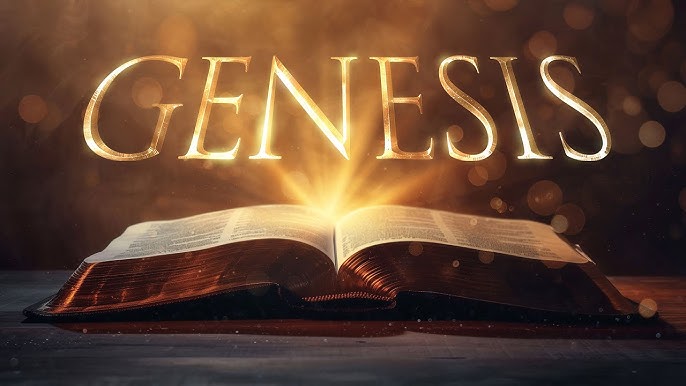In the vast library of ancient wisdom that is the Bible, few books hold as much foundational power as the Book of Genesis. As the first book of Scripture, Genesis lays the groundwork for understanding the nature of God, humanity, sin, and redemption. It is more than just a record of beginnings—it is a divinely inspired revelation that explains where we come from, why the world is broken, and how God intends to restore it, and how hope flickers in the darkest corners of human failure. If you have ever pondered the Genesis creation story, wrestled with the concept of original sin in Genesis, or sought glimpses of redemption in the Bible’s first book, this guide is for you.
Spanning 50 chapters, the book of Genesis answers life’s biggest questions: Where did everything begin? What went wrong? And how does God plan to make it right? From the majestic symphony of creation to the heartbreaking fall into sin, and onward to the shimmering promise of redemption through faithful covenants, Genesis reveals a God who is both sovereign creator and relentless pursuer of His people.
Understanding the Book of Exodus: Deliverance and Covenant
Overview of the Book of Genesis
The word Genesis means “origin” or “beginning.” It comes from the Greek translation of the Hebrew word Bereshit, which means “in the beginning.” The book opens with the majestic statement:
“In the beginning God created the heaven and the earth.” – Genesis 1:1 (KJV)
Genesis serves as the opening chapter of the Pentateuch—the first five books of the Old Testament—traditionally attributed to Moses. It covers approximately 2,300 years of history and sets the stage for the rest of the Bible.
Structure of Genesis
The book can be divided into two main parts:
- Primeval History (Chapters 1–11)
- The Creation of the world
- The Fall of Man
- The Flood and Noah’s Ark
- The Tower of Babel
- Patriarchal History (Chapters 12–50)
- The calling of Abraham
- The lives of Isaac, Jacob, and Joseph
- The establishment of the chosen family through whom God’s covenant blessings would flow
These sections reveal God’s sovereignty over creation and His covenantal relationship with humanity, ultimately pointing forward to the redemptive work of Jesus Christ.
The Majesty of Creation: God’s Blueprint in Genesis 1-2
The Genesis creation story bursts onto the scene with one of the most iconic verses in literature: “In the beginning God created the heavens and the earth” (Genesis 1:1). This isn’t a myth or a poetic fancy; it’s a bold declaration of divine origin. Unlike ancient Near Eastern tales that pit gods against chaotic forces, Genesis portrays a singular, all-powerful God who speaks order into existence effortlessly. Here, creation is ex nihilo—out of nothing—emphasizing God’s transcendence and the universe’s dependence on Him. No pre-existing materials, no cosmic battles; just God’s word as the ultimate creative force.
The Six Days of Creation: God as the Ultimate Source of Life
The opening chapters of Genesis (1–2) narrate the creation of the universe, describing how God brought order and life out of nothing. Unlike other ancient creation myths, Genesis portrays a single, all-powerful God who creates with purpose and perfection.
Understanding the Book of Leviticus: Worship and Holiness
The Six Days of Creation
- Day 1: Light is created; God separates light from darkness.
- Day 2: The firmament (sky) divides the waters.
- Day 3: Land and vegetation appear.
- Day 4: Sun, moon, and stars are set in place.
- Day 5: Sea creatures and birds fill the waters and skies.
- Day 6: Land animals and humanity are created.
Finally, on the seventh day, God rested (Genesis 2:2–3), establishing the Sabbath as a pattern of rest and reflection for all creation.
The Creation of Humanity
The pinnacle of creation was humanity, made in God’s image:
“So God created man in his own image, in the image of God created he him; male and female created he them.” – Genesis 1:27 (KJV)
This imago Dei (image of God) gives humans inherent dignity, worth, and responsibility. Humanity was given dominion over creation—not for exploitation, but for stewardship and care.
Lessons from Creation
- God is Sovereign: Creation did not emerge by chance but by divine command.
- Humanity is Purposeful: Every individual is created for a reason and carries divine purpose.
- Rest Reflects Completion: God’s rest signifies the harmony and order He designed for creation.
The beauty of creation reminds us of God’s goodness, wisdom, and power. However, this perfect world did not remain untainted for long.
The Garden of Eden: Paradise and Partnership
Genesis 2 zooms in on humanity’s origin, recounting the formation of Adam from dust (adamah, linking man to earth) and Eve from his side, symbolizing equality and unity. The Garden of Eden becomes their home: a lush sanctuary where rivers flow, trees bear exquisite fruit, and God walks in the cool of the day (Genesis 2:8-15). Here, work is joy, not toil; relationships are unmarred; and intimacy with God is unbroken.
Yet, two trees stand sentinel: the Tree of Life, offering eternal vitality, and the Tree of the Knowledge of Good and Evil, the test of trust. God commands, “You may surely eat of every tree… but of the tree of the knowledge of good and evil you shall not eat, for in the day that you eat of it you shall surely die” (Genesis 2:16-17). This choice underscores human freedom: Will we partner with God’s wisdom or grasp autonomy?
Understanding the Book of Numbers: Journey and Faithfulness
The creation account isn’t just backstory—it’s the baseline for everything that follows. A “very good” world (Genesis 1:31) sets the stage for sin’s tragedy and redemption’s necessity. As one scholar notes, this goodness implies no death or decay; suffering enters later as an intruder. For modern readers grappling with science-faith tensions, Genesis invites awe at the universe’s fine-tuning—from gravity’s precision to life’s complexity—pointing to an Intelligent Designer.
The Tragic Fall: The Introduction of Sin in Genesis 3
If creation is Genesis’s crescendo of glory, chapter 3 delivers a gut-wrenching pivot: the Fall. The original sin in Genesis isn’t a distant doctrine but a raw human drama, exposing our vulnerability to deception and the cascading cost of rebellion. Enter the serpent—a crafty creature, later identified as Satan (Revelation 12:9)—who slithers into Eden with a question that still echoes: “Did God actually say…?” (Genesis 3:1).
The Temptation: Seeds of Doubt and Disobedience
Eve’s dialogue with the serpent reveals subtle distortions. God said “you shall surely die,” but the serpent twists it: “You will not surely die… you will be like God, knowing good and evil” (Genesis 3:4-5). The lie? Autonomy equals divinity. Already image-bearers, Adam and Eve grasp what God reserved for Himself: the right to define morality. They eat, eyes open to nakedness, and shame floods in.
This isn’t mere rule-breaking; it’s relational rupture. Shame severs vulnerability—fig leaves become hasty cover (Genesis 3:7). When God confronts them, blame-shifting follows: Adam fingers Eve, Eve the serpent. The innocence of Eden shatters, birthing a world of hiding and accusation.
Consequences: Curses and a Glimmer of Grace
God’s response is poetic justice, not petty vengeance. To the serpent: perpetual enmity, crawling on its belly (Genesis 3:14). To Eve: pain in childbirth and relational tension (3:16). To Adam: cursed ground, toil, and return to dust (3:17-19). Death—spiritual separation from God, physical decay—enters as promised.
Despite humanity’s fall, Genesis introduces the first promise of redemption—often called the Protoevangelium (the first gospel).
“And I will put enmity between thee and the woman, and between thy seed and her seed; it shall bruise thy head, and thou shalt bruise his heel.” – Genesis 3:15 (KJV)
This prophecy points to the coming of Jesus Christ, the seed of the woman, who would ultimately defeat Satan and restore humanity’s relationship with God.
Understanding the Book of Deuteronomy: Law and Covenant Renewal
The Fall explains the human condition: Why do we crave control? Why does beauty coexist with brokenness? Sin isn’t just personal failure; it’s cosmic disorder, corrupting relationships—with God, others, self, and creation. As Romans 8:20 later echoes, “the creation was subjected to futility.” But Genesis doesn’t end in despair; it pivots toward rescue.
The Ripple Effects of Sin: From Cain to Babel in Genesis 4-11
Sin doesn’t stay contained in Eden. Like a stone skipped across water, it ripples outward, fracturing families, societies, and the globe. Genesis 4-11 chronicles this downward spiral, yet God’s grief underscores His longing for restoration.
Cain and Abel: The First Bloodshed
Sibling rivalry turns deadly when Cain murders Abel out of jealousy (Genesis 4:8). God’s prior warning—”sin is crouching at the door”—goes unheeded (4:7). Abel’s blood cries for justice; Cain’s exile marks wandering and a cursed lineage of violence, epitomized by Lamech’s vengeful boast (4:23-24). Yet, even here, grace persists: God marks Cain for protection (4:15).
The Flood: Judgment and a Fresh Start
Humanity’s wickedness peaks: “The Lord saw that the wickedness of man was great… and it grieved him to his heart” (Genesis 6:5-6). Violence corrupts the earth, prompting the Flood—a reset button of watery chaos. Noah, “blameless in his generation,” builds the ark (6:9), preserving life as a new Adam. Post-flood, God covenants with rainbow promise: never again total destruction (9:11-17). But sin’s tenacity shows— Noah’s drunken shame and Ham’s dishonor (9:20-27) echo Eden’s nakedness.
Tower of Babel: Hubris and Scattering
Undeterred, humanity clusters at Babel, forging bricks to “make a name” via a sky-scraping ziggurat (11:4). This anti-Eden tower seeks self-glory, inverting God’s multiplication mandate. God confuses languages, scatters peoples—a merciful disruption to curb unified evil. From chaos comes diversity, but isolation breeds nations listed in chapter 10’s Table of Nations.
These chapters paint sin’s anatomy: escalating from personal choice to systemic evil. Relationships crumble—fratricide, exploitation, arrogance—mirroring our world’s headlines. Yet, genealogies thread hope, tracing the serpent-crusher’s line through Seth (4:25-26). God grieves but doesn’t abandon; He preserves a remnant, setting the stage for redemption’s dawn.
Dawn of Hope: God’s Covenant of Redemption in Genesis 12-50
At Genesis’s hinge (12:1-3), the narrative shifts from universal tragedy to particular promise. God calls Abram (later Abraham) from Ur: “Go from your country… and I will make of you a great nation… in you all the families of the earth shall be blessed” (12:1-3). This Abrahamic covenant—land, descendants, blessing—is redemption’s blueprint, countering Babel’s curse.
Abraham: Father of Faith
Abraham’s journey brims with faltering trust—lying about Sarah (12:10-20; 20:1-18)—yet God’s faithfulness shines. The covenant deepens: stars for offspring (15:5), circumcision as sign (17:10-14), Isaac’s miraculous birth (21:1-7). Tested at Moriah (22:1-19), Abraham’s obedience foreshadows substitutionary atonement. His legacy? A people through whom Messiah comes.
Isaac and Jacob: Struggles and Sovereignty
Isaac’s quieter tale passes blessing to scheming Jacob (25:19-34), who wrestles God for renaming: Israel, “he strives with God” (32:24-32). Jacob’s deceptions—stealing Esau’s birthright, favoritism toward Joseph—breed family strife, but God weaves good from threads of evil.
Understanding the Book of Joshua: Conquest and Faith
Joseph: From Pit to Palace
The book’s climax unfolds in Joseph’s saga (37-50). Betrayed by brothers, sold to Egypt, he rises through integrity: “The Lord was with Joseph” (39:2). Famine reunites the family; Joseph’s insight cuts deep: “You meant evil against me, but God meant it for good” (50:20). Egypt becomes a crucible, preserving Israel amid growth.
These patriarchs embody flawed humanity met by unwavering divine commitment. The covenant expands—blessing all nations—linking back to Genesis 3:15. Jacob’s oracle crowns Judah’s line with royal promise (49:8-12), pointing to David and ultimately Christ.
Redemption Foreshadowed in Genesis
- The Sacrifice for Adam and Eve (Genesis 3:21):
God clothed them with garments of skin, symbolizing the shedding of innocent blood for atonement. - Noah and the Ark (Genesis 6–9):
Through Noah, God preserved a righteous remnant and reestablished His covenant, showing His commitment to redemption. - Abraham’s Covenant (Genesis 12–22):
God’s promise to Abraham that “in thee shall all families of the earth be blessed” (Genesis 12:3) was fulfilled in Christ, who came from Abraham’s lineage. - Joseph’s Story (Genesis 37–50):
Despite betrayal and suffering, Joseph’s faithfulness led to the preservation of his family and nation, prefiguring Christ’s redemptive suffering for humanity’s salvation.
The Message of Hope
Genesis reveals that no matter how far humanity falls, God’s grace prevails. His redemptive plan is woven throughout history, culminating in the cross and resurrection of Jesus Christ.
Major Theological Themes in Genesis
a. God’s Sovereignty: God is the Creator, Sustainer, and Ruler over all. Every event—from creation to covenant—demonstrates His absolute authority.
b. Covenant Relationship: God’s covenants with Noah and Abraham reveal His faithfulness and desire to bless humanity through obedience and trust.
c. Human Responsibility: Humans are called to stewardship, faith, and obedience. The choices of Adam, Noah, and Abraham show that faith brings blessing, while rebellion brings judgment.
d. Grace and Redemption: Even after sin, God continually offers a path to reconciliation. Genesis teaches that grace existed long before the law.
Practical Lessons for Believers Today
1. Recognize God as the Creator and Sustainer: Modern society often promotes self-sufficiency, but Genesis reminds us that life, purpose, and order come from God alone.
2. Understand the Seriousness of Sin: Sin still separates people from God today. Genesis teaches us to take moral accountability seriously and seek forgiveness through Christ.
3. Embrace God’s Covenant Promises: Like Abraham, believers are called to live by faith, trusting in God’s promises even when they seem distant or impossible.
4. Reflect God’s Image in Everyday Life: Being made in God’s image means living with love, justice, creativity, and compassion toward others.
Understanding the Book of Judges: Leadership and Cycles
5. Trust in God’s Redemptive Plan: Just as God turned Joseph’s suffering into salvation for many, He can turn our trials into testimonies of His faithfulness.
The Relevance of Genesis in Modern Times
Although written thousands of years ago, the Book of Genesis remains strikingly relevant today. It answers timeless questions such as:
- Where did we come from?
- Why is the world filled with suffering?
- Is there hope for redemption?
In a world searching for identity, Genesis provides clarity. It reminds us that humanity is not an accident but a reflection of divine purpose and love.
The story of creation, sin, and redemption continues to unfold in every generation as people encounter the living God through His Word.
Conclusion: From Genesis to Glory
The Book of Genesis is far more than an ancient record—it is the beginning of God’s grand narrative of creation, fall, and redemption. It shows that despite human failure, God’s purpose prevails. Through faith, obedience, and covenant, God continues to restore what was lost in Eden.
Understanding the Book of Ruth: Loyalty and Providence
From Adam’s fall to Abraham’s faith, from Noah’s obedience to Joseph’s forgiveness, Genesis paints a portrait of divine grace that points directly to Jesus Christ—the ultimate Redeemer.
“In the beginning God……”
—and from that beginning, His redemptive story continues to this day.



